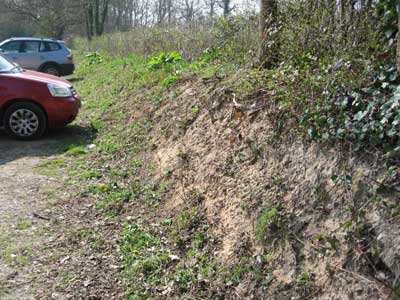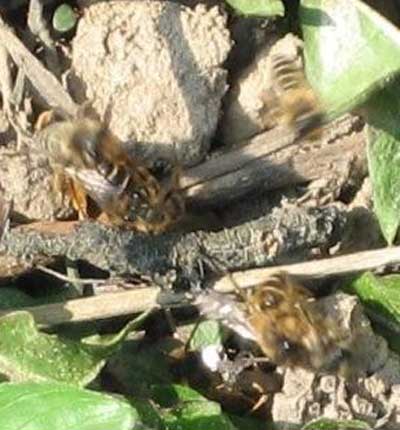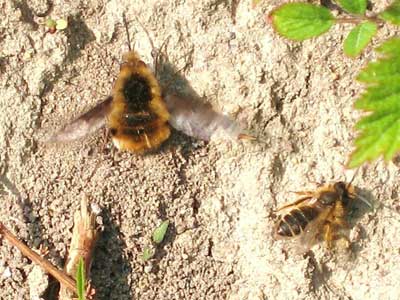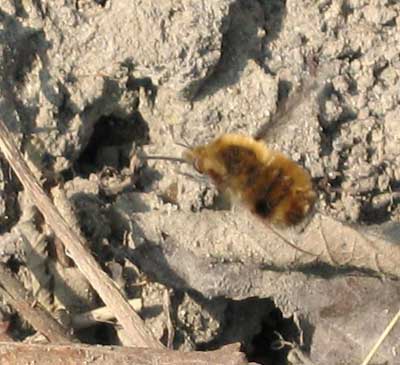All Bee Myself: Solitary Bees
By Ruth D’Alessandro, The Wildlife Gardener The Wildlife Gardener’s opinion was sought this week. It was a warm day and there was a buzz of commotion going on in the school car park. An area was coned off. ‘Swarms of bees’ had appeared. Children would ‘be hurt’. ‘People’ could die of anaphylactic shock. What were the powers that be going to do to get rid of them? What did I think? I think education, not extermination in most incidences. I approached the sandy car park bank:

There were indeed lots of buzzing insects flying about:
They were bees, certainly, but much smaller than honeybees, and some were very small indeed (about 1 cm long). They were emerging from myriad sandy little holes in the bank, buzzing about delightedly in the warm spring sunshine, as you would. I suggested that they were solitary wild bees (probably Colletes sp.) waking up and gettin’ it on to make more solitary bees. As far as I knew, they were harmless, so don’t call pest control before I’ve had a chance to discuss them with The Ranger and find out more. Lucky us! There are relatively few solitary bee habitats, and we have a great big one in our car park. Some solitary bee species in Surrey are very rare indeed so quite possibly we have some. What we are seeing are the bees emerging from their winter quarters. They are no more harmful than flies, in fact less so as they won’t bite or spread disease. The activity in the burrows will become less intense in time as they fly off and start setting up their own nests elsewhere. I went down to the sandy banks this afternoon to do some up-close observation and recording. Little bees flew all around and several landed on me. None stung. Some seemed to be tussling with others and rolling down the bank. I couldn’t make up my mind whether they were fighting or mating:

Another insect, hideous to the uninitiated, moved among the bees, seemingly poised to take advantage ” an unusual bee fly (Bombylius sp.):

That wicked-looking proboscis is in fact used for sucking up nectar, although the bee fly has a sinister relationship with the solitary bees: it lays its eggs in the bee tunnels and the grubs feed on either the bee larvae or their food store.

I could have watched the bees and the bee fly all afternoon, but the car park began to fill up. The Wildlife Gardener had to morph into School Run Mum with all its quotidian responsibilities. Happily, the wonderful school management, rural folk themselves, were very supportive of my’Save the Bees’ stance. An article (probably this one, edited) will go out in next term’s newsletter allaying the fears of any worried parents and highlighting the rare, overlooked, fascinating microcosmos at the edge of the car park.
- Spurn Spawn! - 26th February, 2014
- Bluebells on wheels: axles of evil? - 2nd February, 2011
- Raising the ba: Wildlife and the Ancient Egyptian Book of the Dead - 8th January, 2011

Great article! I’m glad to finally find out what a bee-fly looks like – I thought they were some kind of vicious small horsefly type thing whenever I’ve seen them. I usually rescue bees that fall into the swimming pool and haven’t been rescuing the bee-flies; do I need to feel guilty or am I helping to save bees “proper” if I leave them?!
On another note, does anyone else help poor tired hungry bees, bumble and honey, by feeding them honey off a teaspoon until they revive? I love watching them feed and they seem really grateful!
Thank you so much for the nature lesson on these funny little bees. We first spotted one on a walk through Belhus Park Essex, then in our own back garden and then again in my cousins. Does this mean they are killing off our bees!!! I have copied your info for my little boy to take to school after Easter, Thank you.
Each egg is in its own cell. Some species lay a single egg per nest, all lay only one egg per cell. Most have more than one cell per nest – it’s easier that way.
They all hatch out about the same time and come out of the same hole. Doubtless there’s some jostling. I couldn’t find much of a diagram but try this.
Um.. .I’ve reached my limits as an amateur entomologist, John! The Colletes bees that I’ve read about lay just one egg per burrow, but there may be other species that lay more than one.
Virtual Ranger – help!
Thanks for reply. I am busy preparing another “house” for this year’s brood.
One point, I understood that the bees lay several eggs in a straw, blocking each one from the other. They then, apparently come out in a row. You say “single egg”?
They obviously like your bee house – I’m not sure whether the emerged mated females ‘move next door’ to another straw or go further afield, though.
John – well done with your bee house! I think your male and female young bees are emerging from their individual cocoons where they have developed over winter. Females are mated very soon after their emergence (this would explain the ‘tussling’ bees I witnessed). What you are seeing is a mating frenzy among your emerging bees. Females then go off and make their own little nest burrows, generally close to other solitary bee females so ‘neighbourhoods’ (not colonies) are created. They lay a single egg in an individual cell, and leave some nectar and pollen to feed the larva. The larva feeds on this before pupating the next year. I believe the adult bees die off at the end of the summer.
Can anyone explain the life/breeding cycle of solitary bees please? I have bought a “bee house” which is like a piece of drain pipe filled with straws. Towards the end of last year, nearly all of the straws were blocked off. We took it in for the winter and put it out agin a couple of weeks ago (South east England). Last couple of days has seen massive activity with dozens of bees seemingly going in and out of the blocked “straws” Are they releasing the young/ laying more eggs or are they in fact the young?
So far, none of the unused straws seems to be of interest to the bees.
Hi Bill, I noticed little holes in the sandy bank in the last 2 years, with some to-ing and fro-ing, but to my knowledge this is the first time that the bees have emerged in such number. I believe, as these are solitary bees, each hole would be self-contained and not part of a colony.
I would love to know what’s inside the holes/bank, but the WG budget cannot yet stretch to fibre optic camera attachments!
Do you know anything about the bee colonies under the mounds? I was wondering if they were arranged like a mud dauber colony or yellow jacket colony.
Was the colony new? It is curious that the colony was not noticed before, especially since it is so close to a parking area.
Hurrah for educating the public. With the honey bee decline, wild bees are more important than ever for pollinatint our native and agricultural flowering plants!
Well done for saving the bees! Also thanks for identifying the bee fly as I saw two a couple of weeks ago and thought they might be hoverflies. Fascinating anorak fact too!